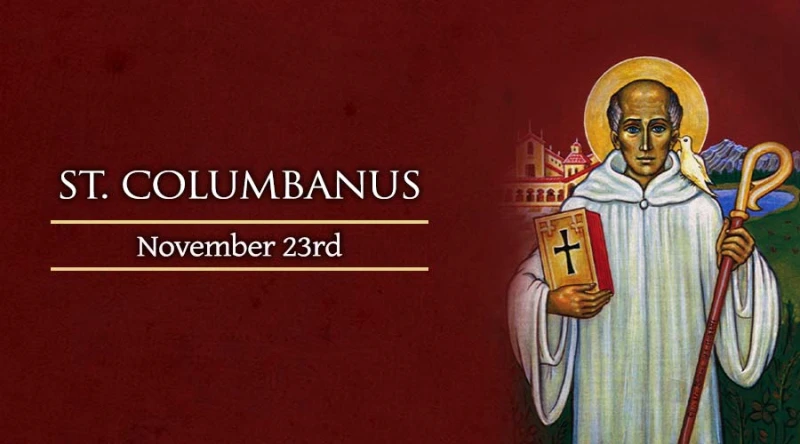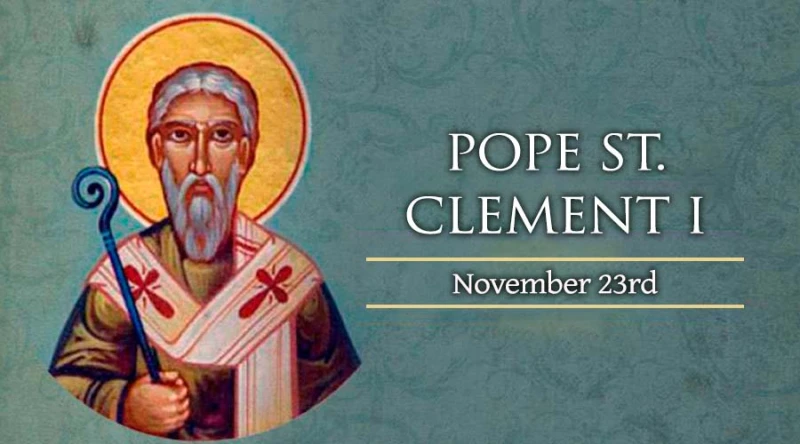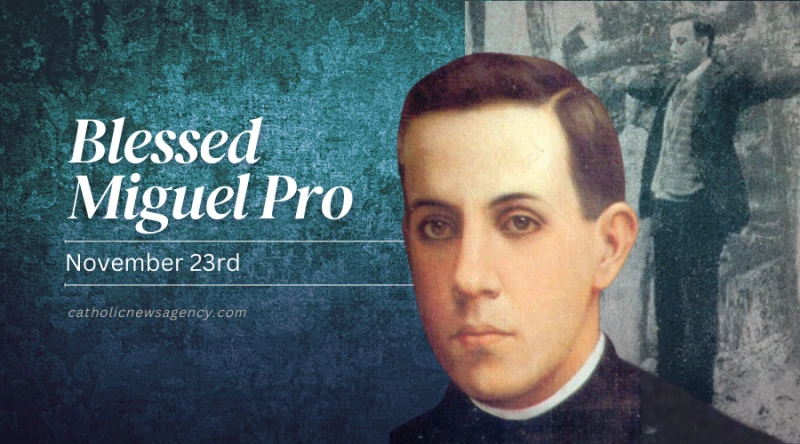-
St. Columbanus
 St. Columbanus St. ColumbanusFeast date: Nov 23
An originator of Ireland's unique monastic tradition, who went on to serve as a missionary to continental Europe during the early Middle Ages, the abbot Saint Columbanus ? also known as St. Columban ? is honored by the Catholic Church on Nov. 23.
Despite their similar names and biographies, St. Columbanus is not the same person as Saint Columba of Iona, another monk from Ireland who spread the faith abroad and lived during the same time period.
In a June 2008 general audience on St. Columbanus, Pope Benedict XVI said he was ?a man of great culture? who also ?proved rich in gifts of grace.? The Pope recalled him as ?a tireless builder of monasteries as well as an intransigent penitential preacher who spent every ounce of his energy on nurturing the Christian roots of Europe which was coming into existence.?
?With his spiritual energy, with his faith, with his love for God and neighbor,? St. Columbanus ?truly became one of the Fathers of Europe.? According to Pope Benedict, the course of the Irish monk's life ?shows us even today the roots from which our Europe can be reborn.?
Born during 543 in the southeastern Irish region of Leinster, Columbanus was well-educated from his early years. Handsome in appearance, he was tempted by women and was eventually advised by a nun to follow her example and flee from temptation by embracing monasticism. His mother disapproved of this intention, but his will prevailed even when she tried to prevent him from leaving home.
The aspiring monk studied initially with Abbot Sinell of Cluaninis, before moving on to a monastery headed by the abbot later canonized as Saint Comgall. It was under his direction, in the Abbey of Bangor in County Down, that Columbanus formally embraced the monastic calling, as one of a growing number of monks drawn to the Bangor community's ascetic rigor and intellectual vitality.
Though Columbanus was known as a dedicated monk and scholar, around the year 583 he felt called to undertake foreign missionary work. Initially denied permission by the abbot, he was eventually allowed to depart with a band of twelve men, with whom he sailed to Britain before reaching France around 585. There, they found the Church suffering from barbarian invasions and internal corruption.
Received with favor by King Gontram of Burgundy, Columbanus and his companions founded a monastery in an abandoned Roman fortress. Despite its remote location in the mountains, the community became a popular pilgrimage site, and also attracted so many monastic vocations that two new monasteries had to be formed to accommodate them.
These monastic communities remained under Columbanus' authority, and their rules of life reflected the Irish tradition in which he had been formed. Meanwhile, as they expanded, the abbot himself sought greater solitude, spending periods of time in a hermitage and communicating with the monks through an intermediary.
As heirs to the Irish monastic tradition, Columbanus and his monks ran into differences with the bishops in France, partly over the calculation of the date of Easter. He also met with opposition from within the French royal family, because of his insistence that King Thierry should not live with a woman outside of wedlock. He had been urged to do so by his grandmother Queen Brunehild, who thought a royal marriage would threaten her own power.
Columbanus' moral stand for marriage led first to his imprisonment, from which he escaped. But the king and his grandmother had him driven out of France by force, and they separated him from his monks by insisting that only those from Ireland could accompany him into exile. This group traveled and evangelized in present-day Germany, though political circumstances eventually forced them to cross the Alps into northern Italy.
Welcomed by the ruling Lombards, Columbanus nonetheless found the Italian Church troubled by heresy and schism. The monk wrote against the Arian heresy (which claimed that Christ was not God but only a highly exalted creature), and asked Pope Saint Boniface IV to help restore the unity of the Church in the region. Columbanus himself was involved in a theological dispute with Pope Boniface, but he remained ?bound to the Chair of Peter? and acknowledged the Pope's authority.
Having received a grant of land from the Lombard king, Columbanus founded his last monastery in the town of Bobbio during 614. Although St. Columbanus died on Nov. 23 of the following year, the abbey at Bobbio remained a center of theological orthodoxy and cultural preservation for centuries afterward.
-
Pope St. Clement I
 Pope St. Clement I Pope St. Clement IFeast date: Nov 23 On Nov. 23 Roman Catholics remember the fourth Pope, St. Clement I, a disciple of the apostles who inherited the authority of St. Peter in the first century. Eastern Catholics celebrate his feast on Nov. 25. The details of Clement's life, before his conversion and even afterward, are largely unknown. Some aspects of his writings have led scholars to believe that the fourth Pope either came from a Jewish background, or had converted to Judaism earlier in life before entering the Catholic Church. Tradition suggests that Clement was the son of a Roman named Faustinus, and that he joined the Church in Rome during its early years through the preaching of Saint Peter or Saint Paul. He went on to share in the missionary journeys of the apostles, and may even have assisted the first Pope in running the Church on a local level. After the deaths of St. Peter's first two successors, the canonized Popes Linus and Cletus, Clement took up St. Peter's position of primacy in the Church around the year 90. One of his most important tasks, during nearly 10 years as Pope, was to resolve serious problems in the Church of Corinth, which St. Paul had also struggled to discipline. Clement's own letter to the Corinthians, though not part of the biblical canon, offers an important look at the role of authority and charity in the early Church. Its introduction suggests that Pope Clement composed it while his own local Church faced persecution from the Roman Emperor Domitian. In the letter, the Pope describes how the Corinthians had once been ?distinguished by humility,? being ?in no respect puffed up with pride? and ?more willing to give than to receive.? But in time, ?the worthless rose up against the honored, those of no reputation against such as were renowned, the foolish against the wise, the young against those advanced in years.? ?Let us give up vain and fruitless cares, and approach to the glorious and venerable rule of our holy calling,? Pope Clement wrote in his call to repentance. ?Let us attend to what is good, pleasing, and acceptable in the sight of him who formed us.? Order and discipline, he noted, are at least as important in the Church as they are in the rest of creation, where the powers of nature follow God's decrees. The Pope also warned the Corinthians to follow ?those who cultivate peace with godliness,? rather than ?those who hypocritically profess to desire it.? The Church Clement headed was one that honored tradition and right order as fundamentals of its life. ?It behooves us to do all things in order, which the Lord has commanded us to perform at stated times,? he told the Corinthians. God, he said, ?has enjoined offerings and service to be performed ... not thoughtlessly or irregularly, but at the appointed times and hours.? ?Where and by whom (God) desires these things to be done, he himself has fixed by his own supreme will, in order that all things being piously done according to his good pleasure, may be acceptable to him.? The fourth Pope's writings reveal much about the early Church, but little about his own life. According to one later account, he died in exile during the reign of the Emperor Trajan, who purportedly banished Clement to Crimea (near modern Ukraine) and had him killed in retaliation for evangelizing the local people. In 868 the Greek missionary St. Cyril claimed to have recovered St. Clement's bones. St. Clement I probably died around the year 100. He is among the saints mentioned in the Western Church's most traditional Eucharistic prayer, the Roman Canon.
-
Blessed Miguel Pro Juarez
 Blessed Miguel Pro Juarez Blessed Miguel Pro JuarezFeast date: Nov 23 Born in Guadalupe on January 13, 1891, Miguel Pro Juarez was one of 11 children. Miguel was, from an early age, intensely spiritual and equally intense in his mischievousness, frequently exasperating his family with his humor and practical jokes. As a child he had a daring precociousness that sometimes went too far, tossing him into near death accidents and illnesses. Miguel was particularly close to his older sister, and after she entered a cloistered convent he began to discern his own vocation, leading him to enter the Jesuit novitiate in El Llano, Michoacan at the age of 20. He studied in Mexico until 1914 when a tidal wave of governmental anti-Catholicism crashed down upon Mexico, forcing the order to flee to Los Gates, California. He then taught in Nicaragua from 1919 until 1922. By the time Fr. Pro was ordained a priest in Enghien, Belgium in 1925, the political situation in Mexico had deteriorated: all Catholic churches were closed, bishops, priests, and religious were rounded up for deportation or imprisonment, and those caught trying to elude capture were shot. The celebration of the sacraments was punishable by imprisonment or death, and the Church was driven underground. Fr. Pro received permission from his superiors to return to Mexico incognito and to carry on his ministry undercover. Fr. Pro slipped into Mexico City and immediately began celebrating Mass and distributing the sacraments, often under imminent threat of discovery by a police force charged with the task of ferreting out hidden pockets of Catholicism. He became known throughout the city as the undercover priest who would show up in the middle of the night dressed as a beggar or a street sweeper to baptize infants, hear confessions, distribute Communion, or perform marriages. Several times, disguised as a policeman, he slipped unnoticed into the police headquarters itself to bring the sacraments to Catholic prisoners before their execution. Using clandestine meeting places, a wardrobe of disguises and coded messages to the underground Catholics, Fr. Pro carried on his priestly work for the Mexican faithful under his care. A failed attempt in November 1927 to assassinate the President of Mexico which only wounded him provided the state with a pretext for arresting Fr. Pro with his brothers Humberto and Roberto. They were put in jail and held without trial for ten days, accused of the attempted assassination. On July 17, 1928, President Calles ordered Fr. Pro to be executed, ostensibly for his role in the assassination plot, but in reality for his defiance of the laws banning Catholicism. As Fr. Pro walked from his cell to the prison courtyard, he blessed the firing squad and then knelt and prayed silently for a few moments. Refusing a blindfold, he stood, faced the firing squad, and with a crucifix in one hand and a rosary in the other, he held his arms outstretched in the form of a cross and in a loud, clear voice cried out, "May God have mercy on you! May God bless you! Lord, Thou knowest that I am innocent! With all my heart I forgive my enemies!" As the soldiers lifted their rifles, he exclaimed in a loud voice, "Viva Cristo Rey!" - "Long live Christ the King!" A volley rang out and Fr. Pro fell to the ground riddled with bullets. A solider stepped up and discharged his rifle at point blank range into the priest?s temple. 30,000 people attended his funeral procession. Fr. Miguel Pro was beatified on September 25, 1988 by Pope John Paul II. Fr. Pro used his natural gifts of intense determination and courage, seen throughout all parts of his life, to further the kingdom of God. Modern Catholics may follow Fr. Pro by taking courage and using their natural talents and gifts as God asks of them.
|




